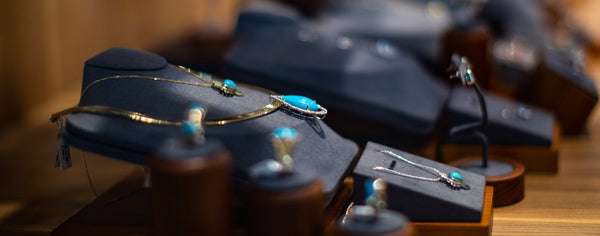Antique and vintage jewelry hold a timeless allure. These exquisite pieces symbolize personal style and serve as gateways to the rich history of craftsmanship and design.
In the jewelry world, the words antique and vintage are often used interchangeably. However, they carry distinct meanings that distinguish them from one another.
Understanding the differences between the two can help you appreciate their unique charms and make informed decisions when adding these treasures to your jewelry collection.
In this blog, we explore what makes jewelry antique or vintage, unraveling the characteristics, eras, and aesthetic influences that define each category.

Antique Jewelry Defined
Antique jewelry refers to pieces that are typically over 100 years old. They were crafted during a specific historical period and reflect the design styles and materials commonly used during that time.
The following characteristics distinguish antique jewelry from its vintage counterparts:
- Antique jewelry is defined by its age. To earn the designation, it must be at least a century old. Most antique jewelry pieces have survived through generations, carrying with them a sense of history. If you’re unsure of a jewelry’s age, a master jewelry can help determine the period it was designed by examining the gemstones, materials, and design features.
- Antique jewelry showcases the meticulous craftsmanship of a bygone era. Skilled artisans of the past used traditional techniques, intricate detailing, and hand-finishing to create exquisite pieces that have stood the test of time.
- One of the hallmarks of antique jewelry is it embodies the design styles and aesthetic influences specific to different historical periods. Each era – Victorian, Art Nouveau, Edwardian, Art Deco – is characterized by distinct motifs, materials, and design elements.
- Another tell-tale sign of antique jewelry is it reflects the precious gemstone preferences of the era. Diamonds, emeralds, pearls, rubies, and sapphires are among the most common gemstones used in antique pieces. Cuts and settings also differ from modern styles.
- Antique jewelry symbolizes the artistic, cultural, and social movements of the era in which it was created.
- Its craftsmanship, historical significance, and rarity combine to make antique jewelry an investment. Antique pieces can appreciate over time, particularly if you keep them well-preserved and maintained.
- Yellow gold, rose gold, platinum, and silver are among the most common materials found in vintage jewelry. Gold was popular in the more intricate pieces because of its malleability.
- Due to their age and historical context, antique pieces are rare. Authenticity is critical if you plan to invest in an antique piece for your collection because replicas and reproductions exist in the marketplace. Work with a reliable source to ensure authenticity before buying. An Albuquerque jeweler specializing in antique pieces can verify if you have a true antique.

Exploring the Allure of Vintage Jewelry
Vintage jewelry refers to pieces that were crafted during a specific era or period in the past. No strict consensus exists on the exact timeframe. However, most jewelers agree that vintage jewelry typically includes pieces created between the 1920s and the 1980s.
Several distinct eras produced vintage jewelry, each influencing the design and style of the pieces.
- Art Deco pieces are characterized by geometric shapes, bold colors, and intricate designs. It’s meant to reflect the glamour and excitement of the Roaring Twenties. Platinum and white gold were popular metals. They were often adorned with vibrant gemstones like diamonds, emeralds, and sapphires.
- Retro pieces emerged during World War II, reflecting a sense of optimism and romanticism. Large, bold designs with curves, ribbons, and bows were common during this period. Yellow and rose gold were favorite materials, accompanied by gemstones like aquamarines, amethysts, and rubies.
- Mid-Century Modern pieces peaked between the 1950s and 1960s, with a shift toward sleek and streamlined designs. Clean lines, abstract motifs, and innovative materials were the hallmarks of jewelry crafted during this period. Popular gemstones included diamonds, pearls, and colored gemstones like citrine and topaz.
- Mod and Psychedelic pieces hit the jewelry scene during the 1960s and 1970s, and were inspired by the counterculture movement. Pieces embraced bold and psychedelic designs, with colors, symbols, and shapes playing a significant role. Materials like plastic and enamel were popular and used alongside traditional metals and gemstones.
- Retro-Futurism pieces experienced a revival in the 1980s, combining futuristic elements with oversized statement pieces. Yellow gold, pearls, and colorful gemstones like opals and tourmalines were popular.
Vintage jewelry offers the unique opportunity to own and wear pieces that capture the nostalgia and style of past decades. Consider adding it to your jewelry collection to pay homage to the fashion and sentiment of bygone eras.
Unsure of the period from which your vintage jewelry hails? Consult with an Albuquerque jeweler familiar with vintage pieces to get an official assessment.

Caring for Antique and Vintage Jewelry
Valuable antique jewelry pieces require special care to preserve their appearance and their value. If you’ve recently inherited or purchased your first antique jewelry item, you may benefit from a visit to an Albuquerque jeweler who can provide explicit instructions to preserve and protect it.
Some of the care instructions you may receive for antiques includes:
- Handle with care to avoid accidental damage or breakage. Avoid touching gemstones or delicate settings because repeated exposure to the natural oils from your skin can affect their appearance.
- Clean sparingly and only using gentle cleaning methods approved for the materials and gemstones featured in the piece.
- Store safely in a clean, dry, and low-humidity environment. Keep antique pieces separate to prevent tangling and scratching. Use non-abrasive, soft materials like jewelry pouches to protect against dust, moisture, and direct sunlight.
- Protect from chemicals like household cleaners, perfumes, hairsprays, and lotions that can damage metal, gemstones, and delicate enameling.
- Seek periodic appraisals and inspections to ensure the condition, authenticity, and value of your antique jewelry.
- Wear with care and remove antique pieces before engaging in any activities that can cause excessive force or impact.
Care instructions for vintage pieces varies depending on the materials and gemstones used in their design. However, most of the recommendations for keeping them in the best shape possible mirror those suggested for antique jewelry.
If your vintage pieces become damaged, seek the help of an Albuquerque jeweler who specializes in their repair and restoration.

Vintage vs. Antique: You Don’t Have to Choose
Can’t decide between antique or vintage pieces for your jewelry collection? There’s no hard and fast rule that says you must prefer one over the other. Each has its own benefits, charm, and cultural significance. Well-rounded jewelry collectors may appreciate both styles.
Like the idea of a vintage or antique look but don’t want the hassle of owning the real thing? Talk with an Albuquerque jeweler specializing in custom design to craft a knock-off of one of your favorites.













